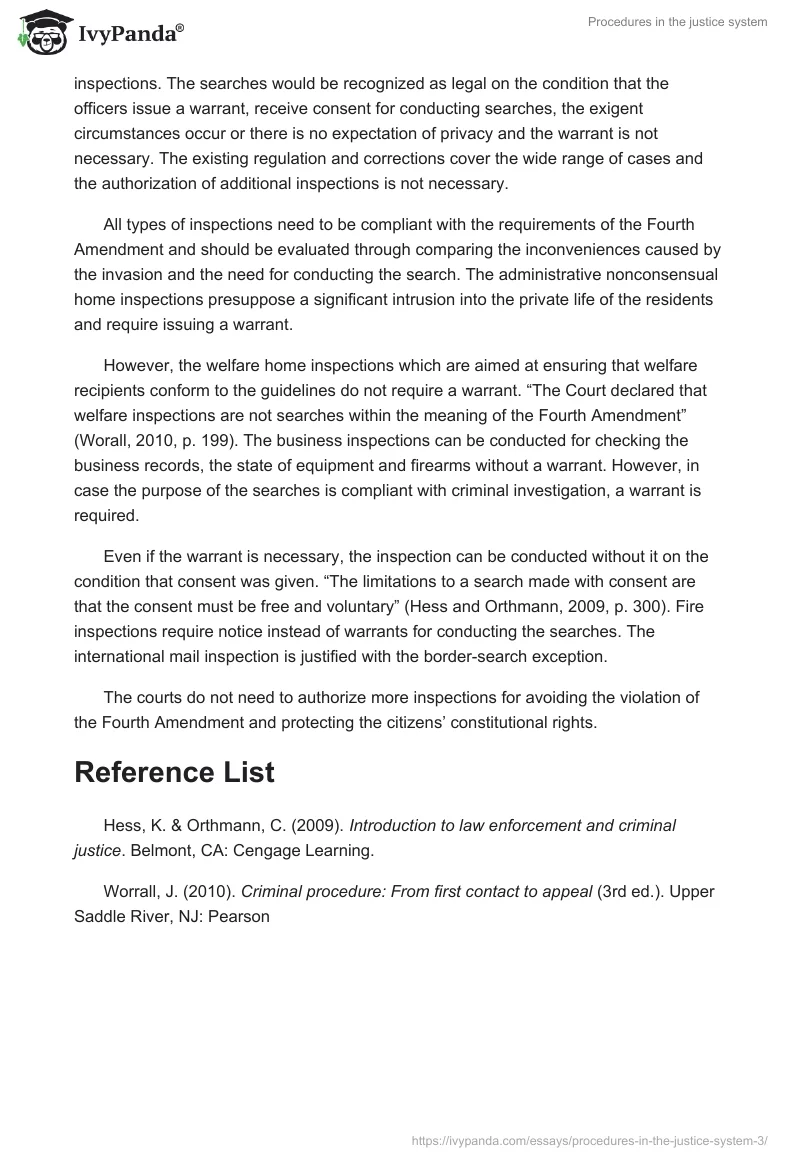The US Supreme Court has sanctioned several types of checkpoints, defining the specific requirements for them. To be recognized as constitutional, a checkpoint has to conform to the constitutional requirements of its briefness, minimization of its intrusiveness and not direct relation to the criminal investigation. With the wide range of existing checkpoints which have been already authorized by the courts, more measures should not be sanctioned for protecting the citizens’ constitutional rights.
The validity of every single checkpoint can be measured by its conformity to the constitutional norms and requires considering the peculiarities of every single situation. The border and sobriety checkpoints as well as informational roadblocks are recognized as constitutional.
As it was cited in Hess and Orthmann (2009) the Court admitted in the case United States vs. Martinez-Fuerte in 1976 that “a vehicle may be stopped at a fixed checkpoint for brief questioning of its occupants even though there is no reason to believe the particular vehicle contains aliens” (p. 272).
The drug, general crime control and driver’s license checkpoints have been recognized as violating the Fourth Amendment and are not sanctioned as constitutional by the Court. The possibility that any motorist committed a crime is insufficient for sanctioning the stops. “The administrative rationale is not acceptable, by comparison, to detect evidence of criminal activity” (Worall, 2010, p. 208).
The case City of Indianapolis vs. Edmond demonstrated that the city’s administrative checkpoints without individualized suspicion were unconstitutional. The authorization of these measures would violate the Fourth Amendment and make the reasonless intrusion into the private life of citizens a part of America’s routine.
The authorization of a checkpoint requires balancing the security demands with the citizens’ constitutional rights. For this reason, the legalization of additional checkpoints is not necessary.
The US Supreme Court has recognized the four main types of inspections, namely home inspections, business inspections, fire inspections and international mail inspections. The searches would be recognized as legal on the condition that the officers issue a warrant, receive consent for conducting searches, the exigent circumstances occur or there is no expectation of privacy and the warrant is not necessary. The existing regulation and corrections cover the wide range of cases and the authorization of additional inspections is not necessary.
All types of inspections need to be compliant with the requirements of the Fourth Amendment and should be evaluated through comparing the inconveniences caused by the invasion and the need for conducting the search. The administrative nonconsensual home inspections presuppose a significant intrusion into the private life of the residents and require issuing a warrant.
However, the welfare home inspections which are aimed at ensuring that welfare recipients conform to the guidelines do not require a warrant. “The Court declared that welfare inspections are not searches within the meaning of the Fourth Amendment” (Worall, 2010, p. 199). The business inspections can be conducted for checking the business records, the state of equipment and firearms without a warrant. However, in case the purpose of the searches is compliant with criminal investigation, a warrant is required.
Even if the warrant is necessary, the inspection can be conducted without it on the condition that consent was given. “The limitations to a search made with consent are that the consent must be free and voluntary” (Hess and Orthmann, 2009, p. 300). Fire inspections require notice instead of warrants for conducting the searches. The international mail inspection is justified with the border-search exception.
The courts do not need to authorize more inspections for avoiding the violation of the Fourth Amendment and protecting the citizens’ constitutional rights.
Reference List
Hess, K. & Orthmann, C. (2009). Introduction to law enforcement and criminal justice. Belmont, CA: Cengage Learning.
Worrall, J. (2010). Criminal procedure: From first contact to appeal (3rd ed.). Upper Saddle River, NJ: Pearson


